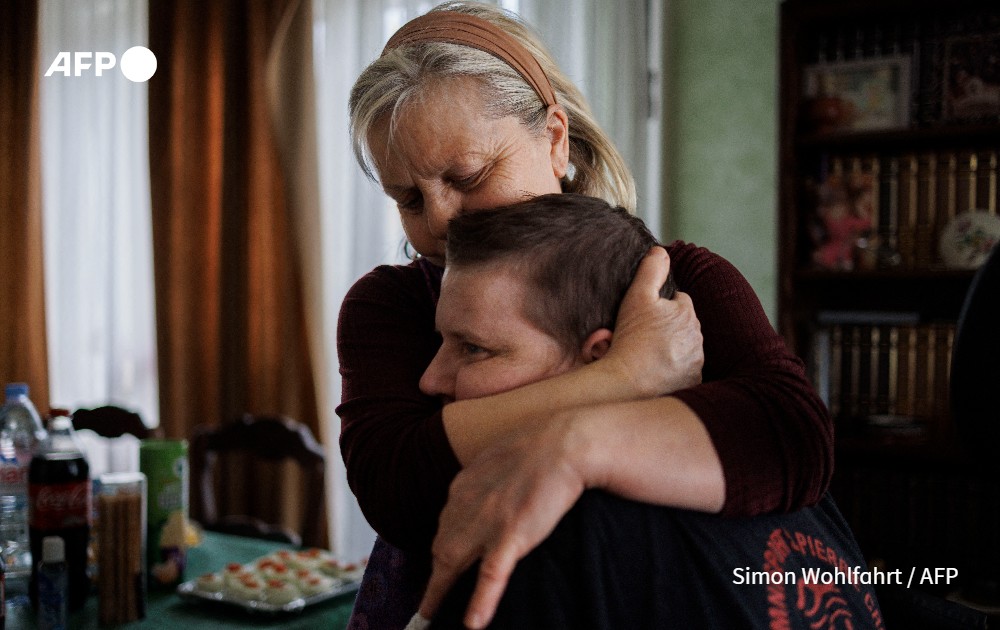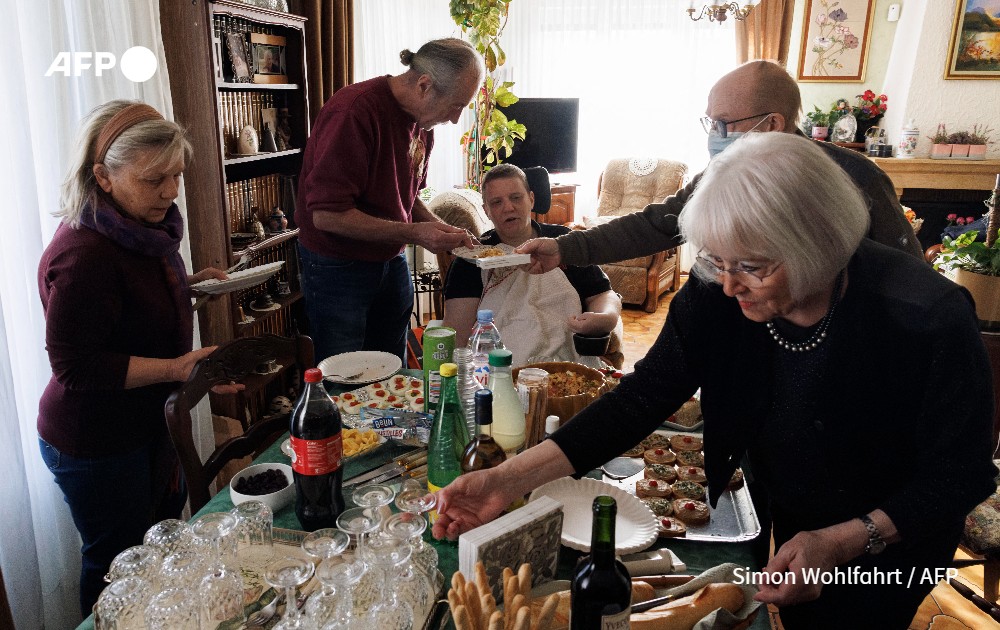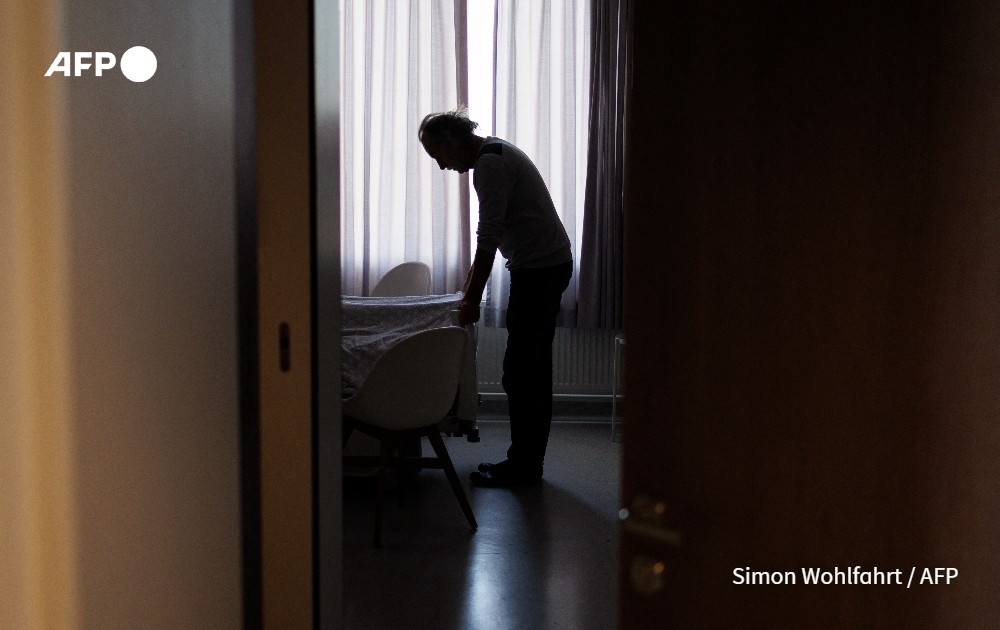Inside AFP
BACKSTORY I Euthanasia - How one “remarkable woman” invited AFP on her final journey
Born nearly blind and paralysed down one side, Lydie Imhoff didn't want to "live in a dead body" after she began losing the use of the rest of her limbs after a disabled riding accident.

Lydie Imhoff (R) is hugged by her friend and carer Marie-Josee Rousseaux during her farewell party in Longwy, northern France, on January 31, 2024.
AFP journalists followed her through her final months, from the day she was given the green light to undergo euthanasia in March 2023 to her final moments in a Belgian hospital. In this Backstory we look at the dilemmas of covering such an emotive and controversial subject so close up.
FIRST CONTACT
Despite being hemiplegic, Lydie Imhoff loved riding horses. But after a serious accident near her home in Besancon in eastern France, the 43-year-old who also suffered from Crohn's disease -- felt more and more trapped in her failing body. Euthanasia is outlawed in France but has been legal under strict conditions in neighbouring Belgium since 2002.
AFP photographer Simon Wohlfahrt first met Lydie in March when she travelled to Brussels to see a psychiatrist for the green light.
They had been put together by Belgian doctor Yves de Locht, who looks after many French patients who want to be helped to die. The first thing that struck him about Lydie was her humour - often wickedly black - and her determination to die with dignity. Getting the go-ahead that day clearly had a "liberating" effect on her, he said.
In the 10 months that followed leading up to her death on February 1, she and Wohlfahrt regularly talked and texted. "She would send me jokes, memes. Humour was her thing," the photographer recalled.
"Once she sent me a picture of her rabbit covered in herbs, with the punchline, 'This time, he's got himself into a stew...' She made fun of us all the time, calling us the paparazzi."
Wohlfahrt said he believed Lydie chose to live out her final days and hours in front of their cameras to try to change the law in France. "She could not understand why she had to go abroad (to die)... I think this was her way of criticising this," he added.
“RESPECTING HER WISHES”

Lydie Imhoff (centre) at her farewell party with friends and right-to-die activists in Longwy, northern France, on January 31, 2024.
During the months leading up to Lydie's death, Wohlfahrt and video journalist Dimitri Korczak had been asking themselves what they should and should not show of her last moments. But it was clear from the start Lydie had "total control over her own image" and could stop the reporting at any time, Wohlfahrt said. "It was really all about trust."
"Clearly one of the central points was whether we would stay with her in the room when she had the injection," the photographer said. "For Lydie it was clear that we shouldn't. She didn't want it to be photographed. "It was her dignity and her choice... We respected her wishes and it was like that all through the reportage." Despite wanting to go public with what she was doing, he said, "there were moments Lydie wanted to keep for herself".
Jokey as she was, "suffering was such a part of her inner self that she did not want to share it with us," said Korczak. "Which made it all the more touching, because she offered us the chance to accompany her on this journey while sparing us the worst. "She kept the hardest things for herself."
DIVISIVE ISSUE
Despite the trust between Lydie and the journalists, euthanasia remains a difficult issue, which made reporting it so close up complicated. "It is so controversial that people did not want to appear on camera so as not to be associated with it," said Wohlfahrt. "We had carers who looked after Lydie who did not want to be photographed," he said. "You have to talk to people to reassure them. Some accepted in the end, others didn't."
Even the Belgian hospital in which Lydie died did not want to be identified for fear of being inundated with people from abroad trying to contact them. In such a potentially "divisive" situation, both journalists wanted to remain observers and somehow keep a professional distance. "Despite getting attached (to Lydie) and all the laughs and the moments we shared with her... we had that journalistic objective to record something that reflected the reality," said Korczak.
"We simply told the story of one among dozens of French people who go to Belgium every year to benefit from the procedure," he added. "We tried to show that with the most dignity and respect possible, and to avoid being voyeuristic."
“HIDING BEHIND THE CAMERA”
Both admitted to "hiding behind the camera, in the work" when dealing with the feelings that such an emotional subject entails, said Wohlfahrt. But once they got home and looked at what they had shot, all their defences dropped.
"It was an extremely powerful moment. Having been there to witness it, it doesn't leave you unmarked," said the photographer. Korczak said he was "shaken" for several days afterwards. "I just have to look at the images for it to come back" and to catch that "very gentle" look of hers that "went through us all".
They hope to have caught something of this "remarkable woman" in their reporting, which has now gone out across the world, as well as "a little of the emotion" she stirred in them, said Wohlfahrt.
Interviews by Michaëla Cancela-Kieffer in Brussels. Edited by Catherine Triomphe and Fiachra Gibbons in Paris.

Former doctor and carer Denis Rousseaux adjusts the blanket on Lydie Imhoff's hospital bed after she underwent euthanasia in Belgium on February 1, 2024.